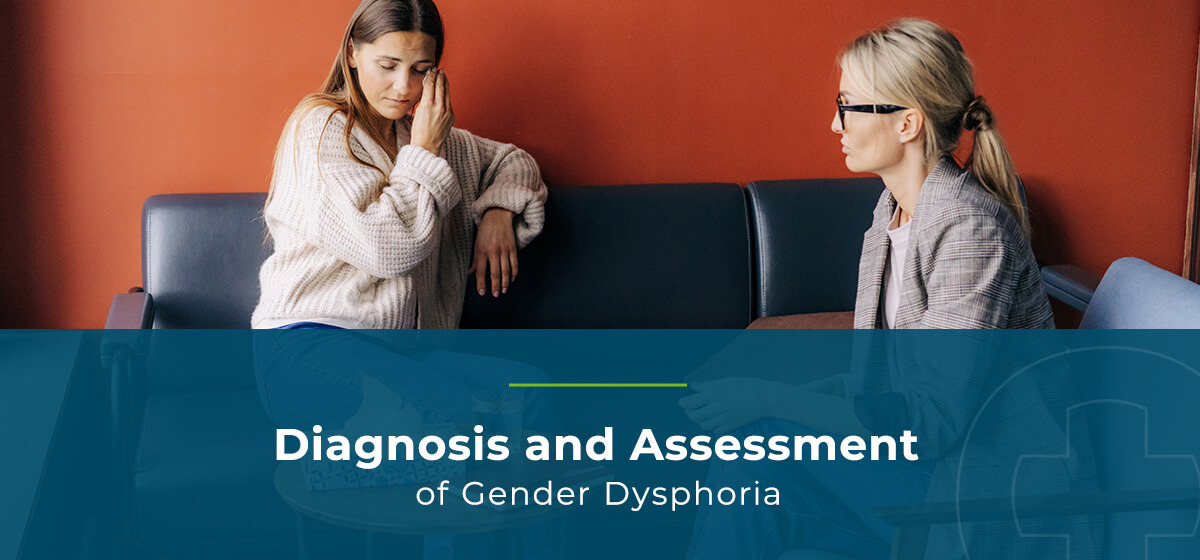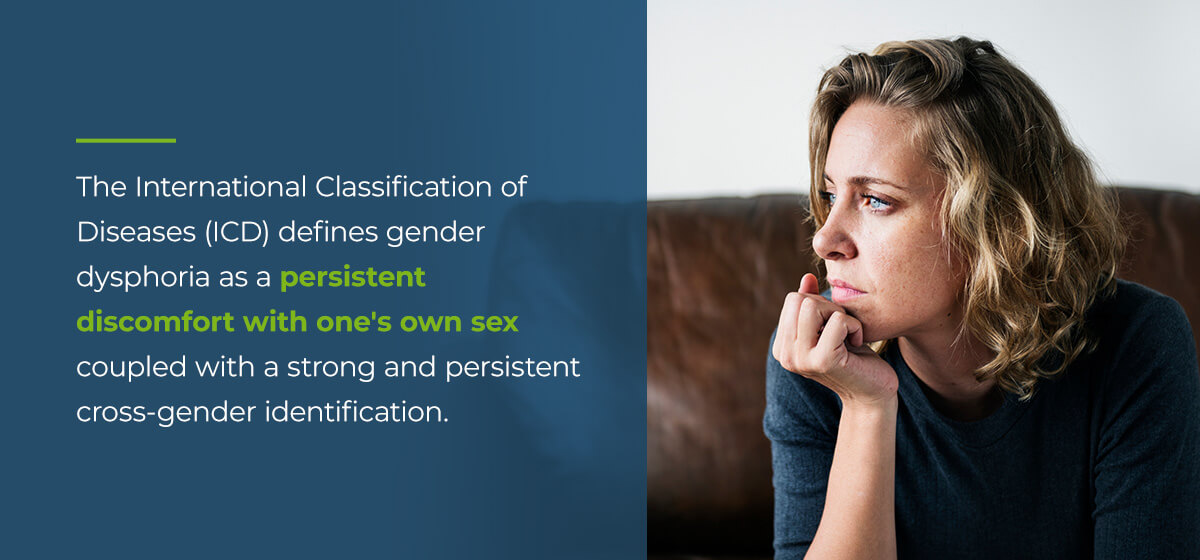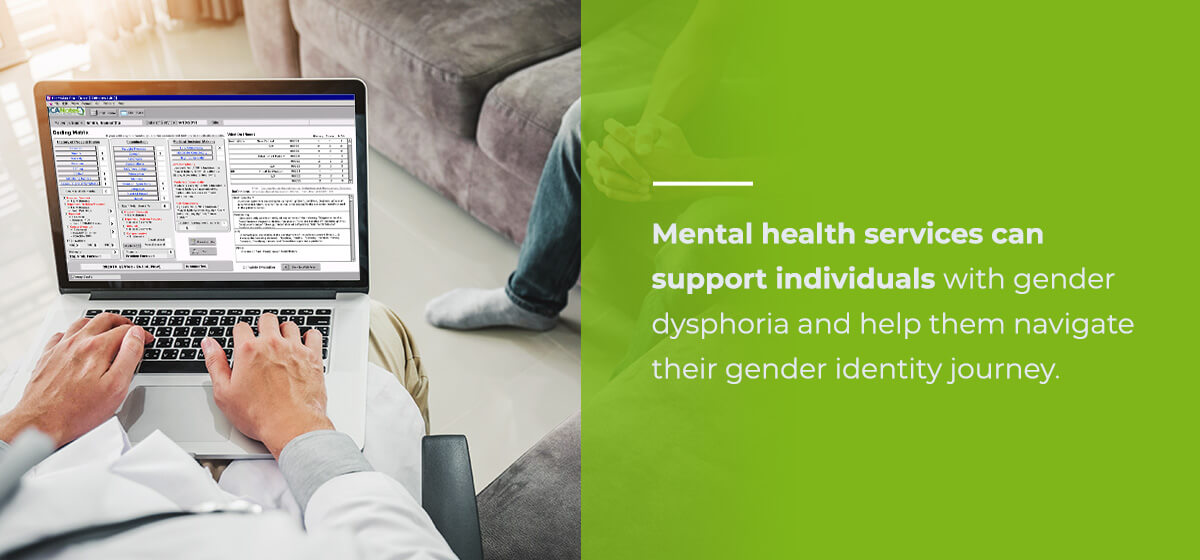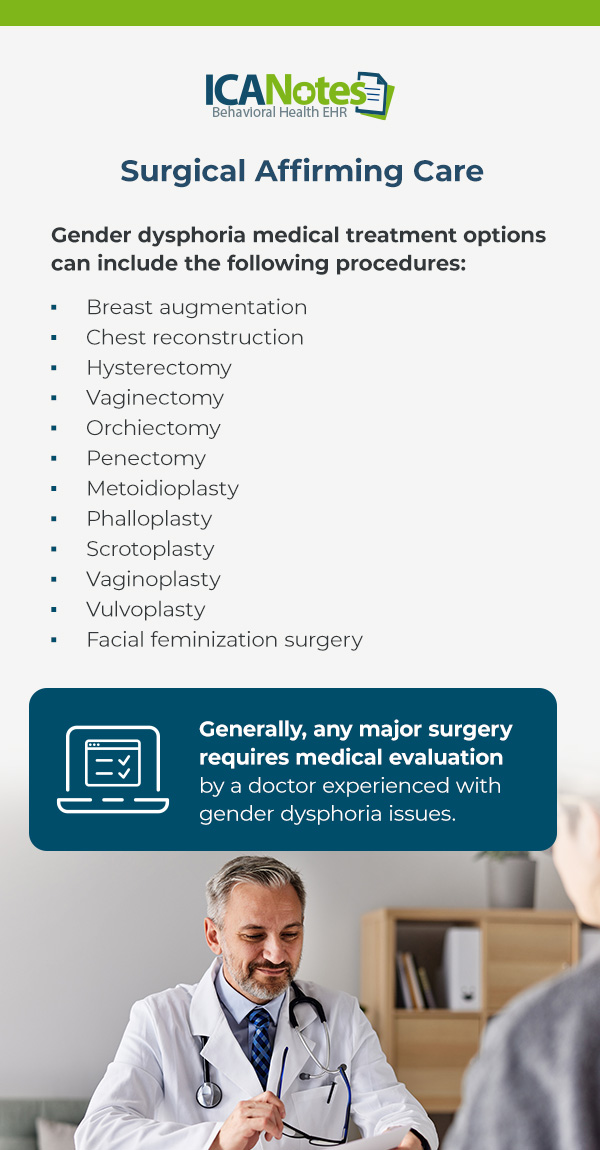
Diagnosis and Assessment of Gender Dysphoria
According to the Pew Research Center, about 5% of young adults aged 18-29 in the United States feel that their gender is different from their assigned sex at birth. Whether they identify as transgender or nonbinary, many of these people struggle with what's called gender dysphoria. This experience is a significant feeling of distress, discomfort or incongruence between one's assigned gender and their experienced or expressed gender.
Individuals may seek treatment for gender dysphoria to help with their self-discovery, to feel supported or to learn more about this new transitional period in their lives. Regardless of the reason, it's important for therapists and counselors to understand the ins and outs of gender dysphoria and how it might appear in patients. Let's take a look at the gender dysphoria diagnosis code as well as some different approaches for assessing and treating this condition.
Instant Webinar
Empowering Mental Health Clinicians: Working with Gender Dysphoria Clients
Join us for a transformative webinar designed for mental health clinicians seeking to deepen their understanding and enhance their skills in providing affirming and culturally competent care to transgender youth and adults.
- Understanding Gender Identity
- Challenges and Resilience
- Beyond the Basics
- Inclusive Language and Terminology
- Expanding Your Framework
Access this instant webinar and join us in making a meaningful difference in the lives of transgender individuals seeking mental health services. Together, we can create a more inclusive, respectful, and affirming healthcare environment.
What Is Gender Dysphoria?

The International Classification of Diseases (ICD) defines gender dysphoria, previously known as gender identity disorder, as a persistent discomfort with one's own sex coupled with a strong and persistent cross-gender identification. An individual may frequently pass as the other sex or express a desire to be the other sex. The Diagnostic and Statistical Manual of Mental Disorders (DSM-5-TR) classifies gender dysphoria as an incongruence between one's expressed gender and one's assigned sex at birth.
Individuals with gender dysphoria feel that their assigned sex at birth does not match their gender identity — or psychological sense of their gender. Some individuals who are transgender may experience gender dysphoria throughout their journey or transition. For instance, someone born with male genitalia may psychologically and emotionally identify as female, leading them to feel uneasy, dissatisfied or frustrated with their situation.
Symptoms of gender dysphoria can begin as early as childhood or start later during puberty and adulthood. If you have a patient who believes they may experience gender dysphoria or who shows signs of gender dysphoria, here are some things to look out for:
- General distress or discomfort about their body or identity
- Negative self-image
- Anxiety or depression
- Self-harming behaviors
- Substance abuse
- A strong dislike of their sexual anatomy
- A strong desire to have the sex characteristics of another gender
- A strong desire to be treated as another gender
- Needing social affirmation from others about their gender identity
- Changing their name or pronouns
- Using gender-affirming hormones
It's important to note that one's gender identity is not the same as one's sexual orientation and gender expression, and it is not an indication of a mental disorder. The DSM-5-TR itself states that gender nonconformity is not a mental disorder. Gender dysphoria is strictly a medical diagnosis that can be treated in adults and children who have gone through puberty.
Gender Dysphoria Prevalence and Statistics
As of 2022, it's estimated that around 1.4 million Americans and 25 million global individuals identify as transgender — possibly many more. This study revealed that as many as 0.6% of Americans experience gender dysphoria.
In a 2023 global survey, about 3% of individuals from 30 countries identified as transgender, nonbinary/nonconforming/gender-fluid or another listed gender. It's important to note that not all transgender people suffer from gender dysphoria, and not all individuals with gender dysphoria decide to proceed with gender-affirming treatment. Additionally, not every patient with gender dysphoria identifies as transgender. The two terms are not synonymous.
With these important distinctions in mind, current statistics reveal there's an increasing number of youth seeking professional treatment for gender dysphoria. Research shows that of 42 million patients, approximately 66,000 experienced symptoms of gender dysphoria. The average age of respondents in the study was 34, while the average age of those with gender dysphoria was 26.
Gender dysphoria generally begins in childhood, but many individuals do not experience this condition until after puberty or later as an adult.
The History and Current Standing of Gender Dysphoria
The topics of gender identity and transgender issues have been controversial in many communities for some time. In past decades, some medical professionals may have believed that gender identity issues were related to mental illness. Today, however, there seems to be a general concern for unintentionally stigmatizing groups of transgender people and those who struggle with gender dysphoria.
This could be why many behavioral health professionals prioritize treatment that supports the well-being of patients with gender dysphoria as opposed to trying to "treat" or "cure" it. Though transgender people and gender dysphoria have certainly existed throughout history, there was very little information and education available to the public and industry professionals in the past. For instance, the first two editions of the DSM did not even have a definition or explanation of gender identity.
How the Term 'Gender Dysphoria' Was Born
In the mid-20th century, German-American endocrinologist and sexologist Dr. Harry Benjamin generalized the term transsexual. Benjamin believed that gender identity existed on a continuum and performed one of the earliest gender-reassignment operations in 1953.
Terms like "transsexual" and "transvestite" were previously used to describe transgender individuals, which we now know are inaccurate. Benjamin clearly defined the difference between these terms, contributing to the common use of the term "transgender" in the 1970s.
In 1980, the term "transsexualism" first appeared in the third edition of the DSM, which was later replaced with the term "gender identity disorder" in 1994. In 2013, this term was officially changed to "gender dysphoria," which is what we use today.
Gender dysphoria may be mistakenly used interchangeably with the term "gender incongruence," but the two terms have distinct criteria. Individuals with gender incongruence experience the feeling of unalignment between their gender identity and their assigned gender at birth, while those who have significant distress or unease with their gender incongruence may receive a gender dysphoria diagnosis.
Professional Disagreements for Treating Gender Dysphoria
As for treatment, there have been many different types of medical, surgical and psychological care available for those in any sort of gender transition. Surgical treatment options include hormonal treatment, gender confirmation surgery (GCS) and nongenital or genital feminization or masculinization. Nonsurgical treatment options have included psychosocial therapy and pharmacotherapy for underlying depression and anxiety.
However, these common gender-affirming interventions, which we'll detail below, were not always upheld by experts. Historically, throughout the 1950s and 1960s, medical professionals believed that the correct approach for treating patients who were transgender or expressed gender dysphoria was psychoanalytic therapy. This method largely focused on adjusting the individual to their assigned sex with the goal of altering their desire to live as a different gender. Harry Benjamin was one of the first physicians to challenge this idea.
Today, being transgender or experiencing any type of gender identity transition is not considered a psychiatric disorder and does not justify a diagnosis. Only the gender dysphoria that results from these experiences is diagnosed. Diverse gender expressions and identities are not indications of a mental disorder.

Mental health services can support individuals with gender dysphoria and help them navigate their gender identity journey. Some professionals may encourage patients to engage in ongoing therapy to address any potential co-occurring mental health issues, such as stress or anxiety associated with gender dysphoria and medical interventions.
Among medical and psychological health organizations today, there is a growing consensus that multidisciplinary, collaborative gender affirmative care is particularly important for reducing stigma and discrimination.
Clinical Diagnostic Criteria for Gender Dysphoria
As a therapist, there are certain criteria you will want to be aware of if you should need to perform a gender dysphoria assessment on your patient. Keep in mind there are different approaches to assessing gender dysphoria in individuals, especially between childhood and adulthood.
According to the latest DSM guidelines, an individual must meet some of the criteria for a gender dysphoria diagnosis and have experienced these symptoms for a duration of at least six months.
In children, at least some of the following criteria must be present for a gender dysphoria diagnosis:
- Fantasizing about being the opposite gender
- Playing make-believe in roles or activities of the opposite gender
- Rejection of activities, games, clothing or toys typical of their sex
- Preferences for activities, games, clothing or toys of the opposite sex
- Persistent desire or belief that they belong to another sex
- In males, a preference for feminine clothing, such as dresses
- In females, a preference for wearing masculine clothing
- Preferences for friends and peers of the other sex
- Experiencing general distress or social impairment
- Dislike for their sexual anatomy
In adolescents and adults, at least some of the following criteria must be present for a diagnosis:
- Strong feelings or convictions that they are feeling in accordance with their identified gender
- Strong desire to belong to their identified gender
- Feeling mismatched in their identity between their primary sex characteristics and expressed gender
- Strong desire to rid themselves of sexual characteristics of their assigned biological sex
- Strong desire to be treated as their identified gender
- General feelings of significant distress regarding their gender identity
Treatment and Care for Gender Dysphoria
The primary goal of gender dysphoria treatment, regardless of the age of your patient, is to address any negative emotions or distress the individual may feel. Evidence shows that individuals who receive treatment for gender dysphoria report happier lives. Here are some of the most common ways to ease gender dysphoria.
Nonsurgical Affirming Care
Gender-affirming care is medically necessary for many individuals who experience symptoms of gender dysphoria, but it does not always involve surgery. Some individuals may desire supportive medical interventions and nonsurgical care options that help them feel affirmed in their expressed gender, such as:
- Breast padding
- Breast binding
- Genital tucking
- Packing
- Speech therapy
- Laser hair removal
- Hair
- Cosmetic injectables
Not every person with gender dysphoria desires medical transitioning or changes at all. Some patients may be satisfied to express their gender identity by changing their clothing, hair, pronouns or name.
Hormone Therapy
Some people with gender dysphoria wish to develop more physical characteristics that align with their affirmed gender. The use of hormones like testosterone and estrogen can encourage the development of certain physical traits, such as a more feminine or masculine voice. This is a common type of nonsurgical gender-affirming care.
Puberty blockers, or hormone blockers, can also be used to temporarily pause or delay the changes that occur to one's body during puberty. This treatment method is reversible and generally used for adolescents with gender dysphoria.
A mental health study from 2022 revealed that the use of hormones and puberty blockers as gender-affirming care was associated with mitigating mental health issues among transgender youth. Due to societal stigma, family rejection and discrimination, transgender and nonbinary youth have significantly higher rates of anxiety, depression and suicidal ideation. Gender-affirming hormones and puberty blockers contributed to lowering depression by 60% and self-harm or suicidal thoughts by 73%.
The Stanford University School of Medicine published a survey that revealed that those who started gender-affirming hormone treatment as teenagers displayed better mental health and experienced fewer substance abuse problems than those who waited until adulthood.
Surgical Affirming Care

Gender dysphoria medical treatment options can include the following procedures:
- Breast augmentation
- Chest reconstruction
- Hysterectomy
- Vaginectomy
- Orchiectomy
- Penectomy
- Metoidioplasty
- Phalloplasty
- Scrotoplasty
- Vaginoplasty
- Vulvoplasty
- Facial feminization surgery
Surgeries like vaginoplasty have been correlated with reduced rates of depression, suicidality and gender dysphoria. An estimated 67% of transgender women who undergo hormone therapy decide to undergo surgical breast augmentation, and the benefits of these surgeries are also associated with psychological well-being, sexual well-being and overall satisfaction.
Some individuals may also wish to have hair transplant procedures to have their physical body better reflect their gender identity. Generally, any major surgery requires medical evaluation by a doctor experienced with gender dysphoria issues. It may also require assessment and evaluation by a psychologist, psychiatrist or another licensed behavioral health professional.
Behavioral Health Treatment
Some individuals who experience gender dysphoria may not wish to undergo surgery. Regardless, seeking psychosocial therapy is an effective way for them to feel validated in their gender identity journey. Therapy is not intended to alter a patient's gender identity. Its purpose is to support the individual's psychological well-being and self-fulfillment. Engaging in ongoing therapy with an experienced professional can help reduce distressing feelings and allow patients to explore gender concerns in a safe environment.
Gender dysphoria can be extremely uncomfortable and upsetting for some individuals, resulting in various mental and emotional health issues. Psychosocial therapy and counseling can support patients as they address their gender incongruence and build self-acceptance.
Counseling may also help patients explore their identity, understand the impacts on their lives and relationships, make decisions about potential medical treatment options, and increase their quality of life.
Community Services
In addition to counseling, therapists can also direct their patients toward community services like peer support groups and social services to deal with parenting issues, workplace issues and minority stress.
Use ICANotes to Create Comprehensive Gender Dysphoria Treatment Plans
Individuals with gender dysphoria will all have unique situations, needs and symptoms. By learning more about the nuances of gender identity and gender expression, you can provide better care to your clients and help them on their personal journey to becoming who they want to be. With the right documentation tools from ICANotes, you can keep your patient's treatment plans organized and create unique therapy notes to review before every session.
Instead of spending hours on clinical documentation, ICANotes behavioral health software makes it easy to reduce note-writing time, improve compliance, bill more effectively and ensure you get to spend more time with your patients. Schedule a demo today or start your free trial to see how we can help you elevate your treatment.
Start Your Free Trial Today
Linked sources:
- https://www.pewresearch.org/short-reads/2022/06/07/about-5-of-young-adults-in-the-u-s-say-their-gender-is-different-from-their-sex-assigned-at-birth/
- https://www.icd10data.com/ICD10CM/Codes/F01-F99/F60-F69/F64-/F64.9
- https://www.ncbi.nlm.nih.gov/books/NBK532313/
- https://www.cedars-sinai.org/newsroom/most-gender-dysphoria-established-by-age-7-study-finds/
- https://www.psychiatry.org/psychiatrists/diversity/education/transgender-and-gender-nonconforming-patients/gender-dysphoria-diagnosis
- https://www.childrenshospital.org/conditions/gender-dysphoria
- https://www.ncbi.nlm.nih.gov/pmc/articles/PMC9501960/
- https://www.statista.com/statistics/1269778/gender-identity-worldwide-country/
- https://www.ncbi.nlm.nih.gov/pmc/articles/PMC10314610/
- https://www.psychiatry.org/patients-families/gender-dysphoria/what-is-gender-dysphoria
- https://www.ncbi.nlm.nih.gov/pmc/articles/PMC9286744/
- https://www.ncbi.nlm.nih.gov/pmc/articles/PMC9286744/
- https://www.ncbi.nlm.nih.gov/pmc/articles/PMC9286744/
- https://www.ncbi.nlm.nih.gov/pmc/articles/PMC9286744/
- https://www.ncbi.nlm.nih.gov/pmc/articles/PMC9501960/
- https://www.facs.org/for-medical-professionals/news-publications/news-and-articles/bulletin/2021/04/the-rise-and-fall-of-gender-identity-clinics-in-the-1960s-and-1970s/
- https://www.ncbi.nlm.nih.gov/pmc/articles/PMC9985385/
- https://www.news-medical.net/health/Diagnosis-of-Gender-Dysphoria.aspx
- https://www.psychiatry.org/patients-families/gender-dysphoria/what-is-gender-dysphoria
- https://www.ncbi.nlm.nih.gov/pmc/articles/PMC9501960/
- https://epi.washington.edu/news/gender-affirming-hormones-and-puberty-blockers-improve-mental-health-in-transgender-youth/
- https://med.stanford.edu/news/all-news/2022/01/mental-health-hormone-treatment-transgender-people.html
- https://www.mayoclinic.org/diseases-conditions/gender-dysphoria/diagnosis-treatment/drc-20475262
- https://www.ncbi.nlm.nih.gov/pmc/articles/PMC9341318/
- https://www.icanotes.com/features/charting/
- https://icanotes.as.me/demos
- https://www.icanotes.com/free-trial/

